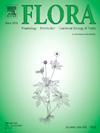巴西东南部塞拉多五种附生球叶的叶片解剖:适应策略和分类价值
IF 1.8
4区 生物学
Q3 ECOLOGY
引用次数: 0
摘要
附生习性在球门中占主导地位。解剖学研究可以阐明附生植物在高温、缺水等极端环境条件下的适应策略。我们的目的是:(1)表征五种球叶属植物(Bulbophyllum chloroglossum Rchb.f)的叶片解剖特征。和温暖。B.附生植物;[题意];, B.剑兰;和B. plummosum Barb.Rodr。识别对附生习性的适应性反应;(ii)调查对类群分类有用的解剖特征的存在。尽可能在植体不同高度采集所研究树种的个体。利用光镜、显微形态学和气孔指数对叶片进行结构表征。所有种都有单层表皮,外周壁厚,下气孔叶,四胞口。叶肉含有带硬核和草酸钙晶体的厚壁组织。维管束是侧支的,被纤维包围。在植体最高处采集的绿舌草个体比在较低高度采集的个体叶片更厚。然而,即使在较低的高度,白杨和剑兰个体的叶片也较厚。在气孔指数方面,绿舌草和羽花草存在显著差异。所有球叶属植物都具有解剖学上的适应策略,如表皮细胞外周壁厚、多水组织、叶片低气孔和沿叶片的晶体。我们确定了物种之间独特的解剖特征,从而确定了识别关键。本文章由计算机程序翻译,如有差异,请以英文原文为准。
Leaf anatomy of five epiphytic Bulbophyllum Thouars (Orchidaceae) species from the Cerrado of southeastern Brazil: adaptive strategies and taxonomic value
The epiphytic habit is predominant in Bulbophyllum. Anatomical studies can elucidate the adaptive strategies of epiphytic species under extreme environmental conditions such as high temperatures and water scarcity. We aimed to: (i) characterize the leaf anatomy of five species of Bulbophyllum: Bulbophyllum chloroglossum Rchb.f. & Warm., B. epiphytum Barb.Rodr., B. exaltatum Lindl., B. gladiatum Lindl., and B. plumosum Barb.Rodr., to identify the adaptive responses to the epiphytic habit; (ii) investigate the presence of anatomical characters useful for the taxonomy of the group. Individuals of the studied species were collected at different heights on the phorophyte whenever possible. The leaves were processed for structural characterization by light microscopy, micromorphometry, and calculation of stomatal index. All species have unistratified epidermis with thick external periclinal walls and hypostomatic leaves with tetracytic stomata. The mesophyll contains hydrenchyma with sclereids and calcium oxalate crystals. The vascular bundles are collateral and surrounded by fibers. The individual of B. chloroglossum collected at the highest height on the phorophyte has a thicker leaf blade compared to the individual collected at a lower height. However, the individuals of B. exaltatum and B. gladiatum had a thicker leaf blade, even at a lower height. Significant differences in the stomatal index occur between B. chloroglossum and B. plumosum. All species of Bulbophyllum possess anatomical adaptive strategies, such as the thick outer periclinal wall of epidermal cells, hydrenchyma, hypostomatic leaf, and crystals along the leaf blade. We identified distinctive anatomical characters among the species, allowing the elaboration of an identification key.
求助全文
通过发布文献求助,成功后即可免费获取论文全文。
去求助
来源期刊

Flora
生物-植物科学
CiteScore
3.30
自引率
10.50%
发文量
130
审稿时长
54 days
期刊介绍:
FLORA publishes original contributions and review articles on plant structure (morphology and anatomy), plant distribution (incl. phylogeography) and plant functional ecology (ecophysiology, population ecology and population genetics, organismic interactions, community ecology, ecosystem ecology). Manuscripts (both original and review articles) on a single topic can be compiled in Special Issues, for which suggestions are welcome.
FLORA, the scientific botanical journal with the longest uninterrupted publication sequence (since 1818), considers manuscripts in the above areas which appeal a broad scientific and international readership. Manuscripts focused on floristics and vegetation science will only be considered if they exceed the pure descriptive approach and have relevance for interpreting plant morphology, distribution or ecology. Manuscripts whose content is restricted to purely systematic and nomenclature matters, to geobotanical aspects of only local interest, to pure applications in agri-, horti- or silviculture and pharmacology, and experimental studies dealing exclusively with investigations at the cellular and subcellular level will not be accepted. Manuscripts dealing with comparative and evolutionary aspects of morphology, anatomy and development are welcome.
 求助内容:
求助内容: 应助结果提醒方式:
应助结果提醒方式:


